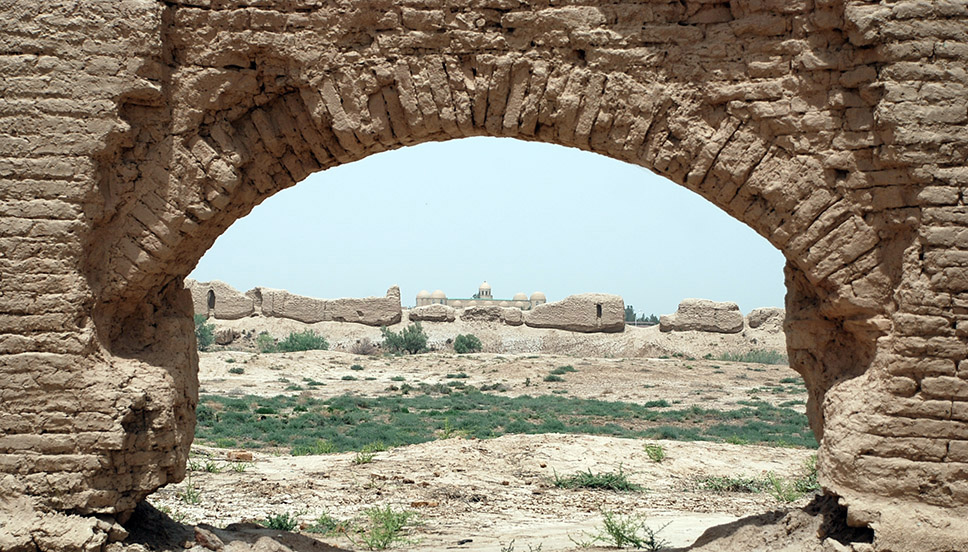Turkmen Jewellery Art
Jewellery is one of the most developed of Turkmen handicrafts. Four tribes are famous for their jewelry: the Yomut, the Tekke, the Ersary and to a lesser extent the Saryk. Turkmen jewelry most often comes in very sober and precise geometric shapes. It is made of silver, decorated with various stones (carnelian, jasper, onyx, agate, turquoise), has a symbolic function, supposed to protect against the - evil eye.
Jewellery makes up a major part of the dowry for brides and is then added to what a young girl receives from her mother. Turkmen jewelry comes in the forms of headdresses, bracelets, earrings, heavy collars and breastplates, in some cases containing magic formulas, verses from Koran, or personal texts. Most of these jewelry made the first half of 19th century and beginning of the 20th century. The Metropolitan Museum has the oldest collection of Turkmen jewelry, dated back to 19th century.
The jewellery for Turkmen women, is the essential part of their life, what compose the beliefs of happiness, health, fertility, protection; the relationship inside of tribe and outside between the tribes societies; the part of the ancestral history and the origins. It combines perfectly with the dresses, enriching it, adding the meaning and the form. Turkmen women change it for everyday life or for the celebration of wedding, circumcision or meeting each other at the evenings or during the work.
The big size and large dimensions are the visual features of jewellery works. The full set of jewellery may be up to 6-8 kg. Even further, the bride set of jewelleries may weigh up to 17 kg. Turkmen artists have amazingly designed the ornaments for all parts of body in a combination with the woman's clothing and variety of tribes, accompanying Turkmen women between the childhood and the old age. Some similarity of the ornaments to the armor points to their past usage in war or conceived as kind of shield, helmet that women used in a battle.
The main material of Turkmen ornaments is silver. The gold is rarely used, mainly only for coating. Another features, is the variety of semiprecious stones (as mentioned before). It seems that red agate (bloodstone) is against bleeding, ulceration and abortion. Blue turquoise protects against the evil eye, which related to rare blue eyes in the area. These jewels of large size and weight produce the impressive motion concert of variety of red-blue-brown- silver colors, forms, stones and decorative tassels of by passing Turkmen women.
The ornaments motifs can be classified to several groups:
Animal motifs:The numerous totemic beliefs were common among the Oghuz tribes. The sheep and wolf have the special places.
Ram's horn as the symbol of nomadic living, fertility, power.
Wolf (She- Wolf) is associated with the Oghuz Turkic foundation myth, appearance of the Turks.
Birds,the symbol of ascension, is presented as abstract and outlined. The birds of prey are admired for their power and glory, selected as the ongon (symbol) of a tribe. Representing the spirits of human being.
Fish symbol of fertility and pregnancy, is offered as abstract at the end of most pendants
Snakeswinding wire, s-shaped forms and the natural image of snake with connection to ancient myths, associated with renewed youth, immortality, longevity and wisdom
Camel motifs as symbol of endurance and tolerance
Herbal, Tree motifs: Mainly (5-9) leaves flowers, in circles or bush-like motifs. Aidi Flower motif with 9 petals as symbol of fertility for women. Tree leaves motif related to the past myths and to shaman rituals.The important was Birch Tree (Dagdan – protection motif, from evil eye and disease. This motif is met on the carpets)
Human motifs: outlined as abstract figures
Celestial motifs: Sun, Moon, Stars. Eight pointed star as the symbol of the sun, symbol of luck and fortune. Sun and Moon motifs as symbol of light and bright to home, represented in a circle motif, in which other circles repeated around it, with surrounding decorative stones as stars.
Geometric motifs: Round, Square, Diamond shaped – used as general forms of the ornaments. The tiny motifs of circle and triangle shown on the jewels.
Stones are worked in the forms of circle, oval or almond shape. Hexagonal, rhomboid, triangle shapes used to prevent the evil eye.
Arabesque or Eslimi motifs: used in most jewels. Another term of Islam, the special abstract motifs, derived form natural and herbal motifs which form in spiral circles. Arabesques curves have inside and outside directions, which is the essence of Eslimi, this direction is infinitive and considered as a symbol of immortality.
